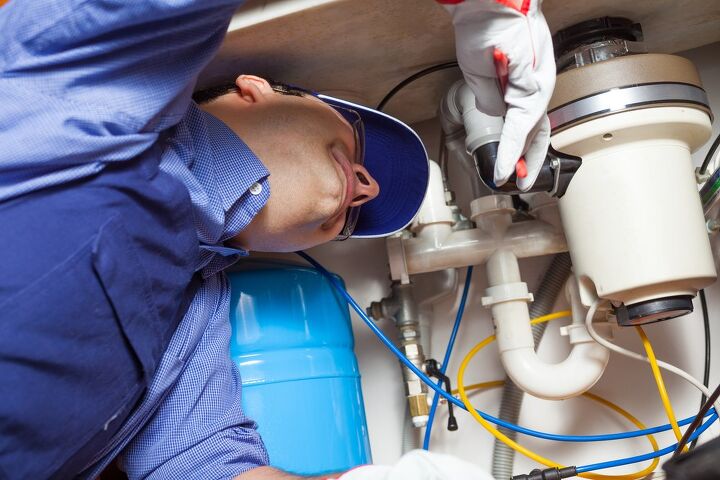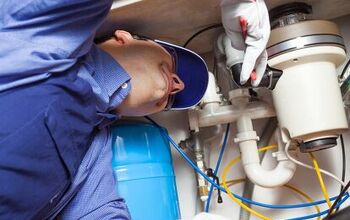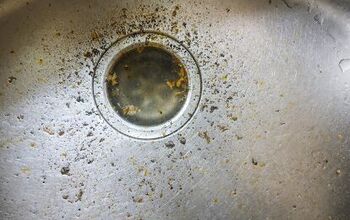Garbage Disposal Lower Than The Drain? (Fix It Now!)

A garbage disposal is beneficial to have in the kitchen. It can take leftover food and blend them down into tiny bits that are easier to dispose of.
A garbage disposal cannot be lower than the drain. The garbage disposal needs gravity to help wash away food particles that are shredded and sent to the waste pipe. Therefore, if the garbage disposal is lower than the drain, you must raise the drain wall. If you cannot raise the drain wall, raising the garbage disposal unit higher can be done.
When you install one yourself you want to make sure that the drain is lower than the garbage disposal. If the garbage disposal is lower than the drain, you will have a problem.
Whether you are installing or fixing a garbage disposal, it is important to understand all the components of the unit. Read on to discover all you need to know about garbage disposal drains and more.
Do You Need to Hire a Plumber?
Get free, zero-commitment quotes from pro contractors near you.

Garbage Disposal Lower Than Drain
When you put food down a garbage disposal, it gets shredded by the shredding ring and flywheel. Most people think there are blades within the garbage disposal that shred food into particles, but this is not true.
The food, once broken down into bits, is washed out through the drain pipe, also known as a waste pipe. The entire process makes it easier for the disposal of leftover food and other biodegradable materials.
Proper handling of a garbage disposal can help mitigate issues. Certain aspects should be considered when you use a garbage disposal, such as:
- Choosing the right food to put down the garbage disposal
- Using cold water each time you use it
- Keeping the garbage disposal clean
- Using the garbage disposal regularly
There needs to be a drain pipe for the garbage disposal. In essence, the garbage disposal is between the sink (where you put the food) and the drain. The garbage disposal has to be higher than the drain because it needs gravity to carry the food particles away.
Why It Is Important
The drain must be lower than the garbage disposal. If the drain is higher than the garbage disposal, it will not work properly.
This can be avoided through proper installation. You must make sure it is configured correctly.
It is important because gravity helps carry the water and shredded foodstuffs down and out of your house. If you have a septic tank, it will go there. If you use the town’s irrigation, it will go there.
The force of the water and the spinning of the flywheel helps push the food out. However, it is gravity that will keep everything moving properly. If the drain were higher, the food would have to travel upward, which would lead to significant clogging.
If the drain is not properly placed, you will have to reconfigure the garbage disposal. This may mean you need to raise the garbage disposal, or you may need to replace the drain pipe.
You may find that you are getting more clogging than you think is normal. If so, you should check underneath the sink to make sure the drain is lower than the drain.
The Parts of the Garbage Disposal
The drain is just one component of a garbage disposal. It is important to understand all the parts of the garbage disposal.
Once you know all the different parts, it is easier to understand how the garbage disposal works. It will also be easier to know why the drain pipe is so important.
The garbage disposal is not overly complicated in its design. The parts are relatively simple, but they should be mentioned. From the top of the unit down to the bottom, the parts include:
- Splash guard
- The upper hopper chamber
- Dishwasher connector
- Shredder ring
- Impellers
- Flywheel
- Motor shaft
- Drain pipe connector
The splash guard is located at the very top of the entire unit. It prevents food particles and water from splashing up at you.
From there, the food travels downward through the upper hopper chamber, the shredder ring, impellers, and flywheel.
The Drain of a Garbage Disposal
The drain pipe is the last component of the garbage disposal. The reason it is important to have the drain lower than the garbage disposal is because of its very design. It is located at the bottom of the garbage disposal for a reason.
When the food gets to the drain pipe, it has become shredded into small particles. These particles are easily washed away by water. Once they have reached this form, it is easier to avoid clogging.
However, if the garbage disposal were to be lower than the drain, clogging would occur much more frequently. The garbage disposal would not work properly. This is why proper installation is so crucial.
Proper Care to Avoid Drain Pipe Clogs
Taking proper care of your garbage disposal will help mitigate clogs. Even when your garbage disposal’s drain is lower than the unit itself, it can still get clogged.
Moreover, the garbage disposal itself can get clogged. So, what can you do to avoid this?
There are several things you can do to help avoid clogs in your garbage disposal. They include:
- Only sending down biodegradable materials
- Cut down the chunks of food beforehand
- Using soft or rotten food
- Using cold water whenever you use the garbage disposal
- Regularly cleaning the garbage disposal to remove grime buildup
- Using the garbage disposal regularly to keep it working properly
The food you put into the garbage disposal has an impact on its efficiency and its ability to avoid clogging. If you were to put down potato peels, nuts, or shells, it could lead to the garbage disposal clogging quickly.
Precutting Foods Before Disposing of Them
You want to focus on other foods, like eggshells, old fruits, small pieces of meat, and so on. However, it is also important to cut these pieces down into small pieces before inserting them into the garbage disposal.
The garbage disposal is built to chop these items down into small particles. However, if the pieces are too big initially, it could jam the unit and clog the drain pipe.
It is important to use cold water because cold water will help keep things solidified, which also helps avoid clogging. Moreover, if you regularly clean the garbage disposal, you will avoid rust, grime, and dirt buildup.
When these things go unchecked, the unit can not work. Using the disposal regularly will also help keep all the moving parts working properly.
Unclogging the Drain Pipe
If you do encounter a clog in the drain pipe or the garbage disposal, it is important to take care of it right away. An untreated clog will only get worse and harm your garbage disposal.
It is important to note that you should never use harsh chemicals in a garbage disposal. While many people usually use chemical drain solution to unclog sinks, it can damage your appliance.
Additionally, if you have a septic tank, the harsh chemicals can damage the bacteria that break down the waste.
The first thing you can do is use a sink auger to manually try and loosen the clog. Sometimes, however, this is not enough. Instead, you can opt for the following method to unclog your garbage disposal.
The Process of Unclogging the Garbage Disposal
To unclog the garbage disposal, pay attention to these points:
- Disconnect the garbage disposal. Whenever there is a clog with a garbage disposal, it is best to disconnect it.
- Clamp the dishwasher line (if applicable). It is best to clamp this down in case you need to plunge the drain.
- Use vinegar and baking soda. Pour a solution of baking soda and vinegar into the drain. Let it sit there for a few minutes. Use hot water to flush the mixture out.
- If the clog has not come undone, you can repeat these steps.
- Use a plunger. Sometimes the clog will still not dissipate after several mixtures have been poured down the drain. Then, you can use a plunger to try and loosen the clog.
- Manually remove the blockage. If you can see the clog, you can manually remove it with pliers. You may also use a sink auger or some other long tool that can loosen the object.
- Run hot water down the drain. Whenever you eventually break up the clog, you should run hot water from the faucet down the garbage disposal.
It may be necessary to repeat all these steps several times to unclog the drain pipe.
Replacing the Garbage Disposal
There are times when you will need to replace your garbage disposal. For example, if the drain pipe is lower than the drain, you will need to raise the drain wall. You may also need to raise the garbage disposal or get a new unit that is properly installed.
Moreover, it is best to first see if you can fix the problem some other way. Whether it is replacing the drain pipe or cleaning the pipe to keep it from clogging. However, if these fixes do not work, getting a new unit is a good idea.
It is important to note, however, that proper installation is key to avoiding issues with the drain pipe. The drain pipe is a vital part of the design of a garbage disposal. It needs to be properly placed. This is so that gravity can help carry away the food particles and water that inevitably will travel through it.
Do You Need to Hire a Plumber?
Get free, zero-commitment quotes from pro contractors near you.

Related Questions
Where should the garbage disposal P-trap be?
The P-trap pipe for a garbage disposal should be located beneath the drain. Additionally, it can be up to 24”, or two feet, below the drain. While it cannot exceed this distance, there is no minimum distance required.
How high is a normal kitchen sink off the floor?
Most kitchen sinks are located around 28” off the ground. This is because the sink itself is usually around 8” deep. This is important to note so you know how much room you have for a garbage disposal.
Can you use an S-trap for a garbage disposal?
No, you may not use an S-trap for your garbage disposal. S-trap pipes are prohibited. They can siphon water out of the trap and cause sewer gases to enter the home. This is why a P-trap is commonly used.

Hannah DeMoss has been a writer for nearly a decade. Her passion for writing began years ago has continued to grow. Her expertise at home involves furniture restoration and other small DIY tasks. When not writing, Hannah enjoys the outdoors with her husband and pups, as well as traveling.
More by Hannah DeMoss





















![How To Reset A Whirlpool Cabrio Washer [In 5 Easy Steps!]](https://cdn-fastly.upgradedhome.com/media/2023/07/31/9076531/how-to-reset-a-whirlpool-cabrio-washer-in-5-easy-steps.jpg?size=350x220)





